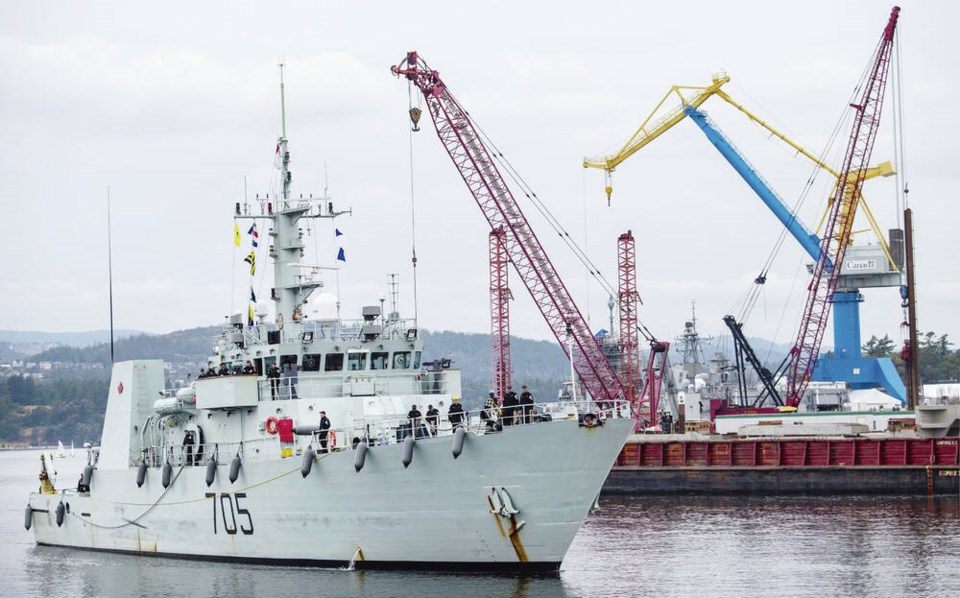The mission of the Navy is to generate combat-capable, multi-purpose maritime forces that support sa国际传媒’s efforts to participate in security operations anywhere in the world. Yet it is doubtful the Navy could be capable of conducting its mission, given how it is equipped.
The navy operates 30 ships; they are 12 Halifax-class frigates, 12 Maritime Coastal Defence Vessels (MCDV), six Arctic Offshore Patrol Ships (AOPS), three are now built and there are three more to come.
Of the 30 surface combatants, 18 have no naval weapons and are certainly not combat-capable. sa国际传媒 now has 12 combat-capable ships to meet its mission requirements.
As a comparison, the Chinese navy has about 500 combat-capable warships, and the U.S. navy assessed the number of combat-capable ships needed to meet its mission requirements to be 373.
Now, what is sa国际传媒’s assessment of combat ships needed?
It should be kept in mind that the mission of the Navy is to provide armed sea-borne surveillance of sa国际传媒’s coasts, and to enforce Canadian sovereignty. How can these missions be carried out with ships that are unarmed? Why is the Navy equipped with ships that could not respond to any type of military threat, or carry out force projection, since they have no armament?
The MCDVs are unarmed (except for two machine guns). They are non-war fighters and cannot be classified as warships, especially since they were built to commercial standards. They should be either transferred to other government agencies, such as fisheries, customs, Coast Guard, or simply fitted with combat systems.
It should be remembered that the ships were initially fitted with a Bofors 40-millimetre gun. The Bofors guns were refurbished Second World War models that had been previously used by the Canadian Army for air defence in Europe. They were removed in 2014. The guns were used as monuments after being removed.
As for the AOPS, only three have so far been delivered, and they carry what is called a constabulary gun. The design for the remaining three should be modified to restore the original Norwegian naval weapon system suite, which consists of a 57mm naval gun and Simbad surface-to-air missiles.
As the Arctic sea ice continues to recede, it is opening new maritime trade routes and other economic opportunities.
The Northwest Passage is the sea route between the Atlantic and Pacific oceans through the Arctic Ocean, along the northern coast of North America via waterways through the Canadian Arctic Archipelago.
sa国际传媒 has great potential for economic growth and prosperity, but other players in the world may seek to infringe on this potential, hence the possibility of conflict over competing interests. The contested sovereignty claims over the waters may complicate future shipping through the region.
Both Russia and China are preparing to exploit the region by developing and building armed icebreakers. Other countries, including the United States, are also taking steps to ensure their access to the region for various reasons such as sea routes and untapped resources.
The U.S. and others have indicated that actual warships are better suited to this frigid environment and have the needed firepower in the event of hostilities.
The 12 frigates are the only ships that can be referred to as warships. Yet sa国际传媒 is a nation that has coasts on three oceans. Why do we not have a navy that can enforce sa国际传媒’s sovereignty over its territorial waters and be able to protect and defend its shores?
The 12 frigates are not enough to carry out this job, the Navy needs more capable ships, fitted with up-to-date weapon systems.
sa国际传媒 should have a navy that can deliver on its primary mission requirements.
It should be remembered that in the event of naval warfare, it is the goal to destroy or disable the enemy’s vessels, and unarmed ships have never impressed an enemy.
>>> To comment on this article, write a letter to the editor: [email protected]



